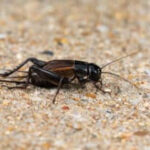Fruit flies, those pesky little insects buzzing around your fruit bowl, can be a real nuisance, but don’t worry, flyermedia.net has got you covered! Eliminating these unwanted guests is easier than you think, and often involves simple household items. Learn how to create effective traps and implement preventative measures to keep your home fruit fly-free. For innovative strategies and expert advice, delve into our resources on pest control and eco-friendly solutions, ensuring a clean and serene environment.
1. What Exactly Are Fruit Flies?
Fruit flies are tiny flying insects that are highly attracted to ripe or fermenting fruits and vegetables. They are also attracted to sugary liquids, such as juice, beer, and wine. These pests, often found near fruit bowls, garbage cans, and drains, measure around the size of a rice grain and look like tan or brownish houseflies with red eyes. They are most common during the summer and fall when fruits are in season.
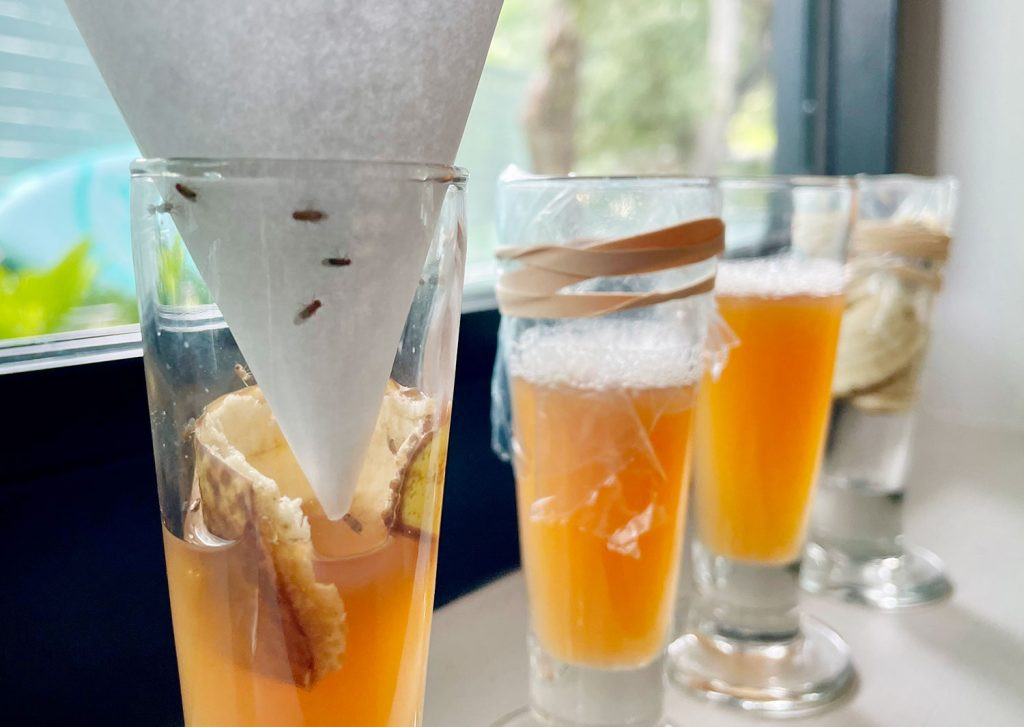 Fruit Flies Trapped In DIY Funnel Trap Method
Fruit Flies Trapped In DIY Funnel Trap Method
A fruit fly infestation can start with just a few flies that hitch a ride on fruits. However, a female fruit fly can lay hundreds of eggs in her short lifespan, with eggs hatching in as little as 12 hours. These flies can reach adulthood within a few days, which means a small number of fruit flies can quickly turn into a major infestation. Therefore, it is essential to get rid of fruit flies as soon as possible.
1.1 What is the difference between Fruit Flies vs. Fungus Gnats vs. Drain Flies?
Fruit flies are often confused with other common household pests like fungus gnats and drain flies. All these insects are small and fly, but knowing how to tell them apart can help you choose the right way to eliminate them. The easiest way to tell them apart is by where you see them and what larger insect they look like.
| Insect | Appearance | Habitat |
|---|---|---|
| Fruit Flies | Small flies | Near fruit bowls, trash cans, and other food sources |
| Drain Flies | Small, fuzzy moths | Near sinks and drains |
| Fungus Gnats | Small mosquitos | Near houseplants, breeding in damp soil |
If you’re not sure which type of insect you’re dealing with, try setting up one of the traps below. If it attracts the pests in your home, you likely have fruit flies.
2. What are the most effective DIY Fruit Fly Traps?
Getting rid of fruit flies doesn’t require complex tools or expensive solutions. All you need are some common household items and a little patience. Every trap works on the same basic idea: attract the fruit fly and then keep it from escaping. The following four DIY methods have proven effective:
- Funnel Trap
- Plastic Wrap Trap
- Dish Soap Trap
- Rotting Fruit Trap
 4 DIY Fruit Fly Traps Tested On Windowsill
4 DIY Fruit Fly Traps Tested On Windowsill
Some traps may work faster than others, so trying more than one might be helpful. Remember that it might take several days to completely get rid of your fruit fly problem.
2.1 How do you make a Funnel Fruit Fly Trap?
This trap lures fruit flies into a container through a small hole at the bottom of a homemade paper funnel. Once inside, the flies struggle to escape through the small opening.
Supplies Needed:
- Small clear jar, cup, or container with a narrow opening
- Piece of paper or cardstock
- Tape
- Scissors
- Apple cider vinegar (ACV)
Instructions:
- Choose Your Container: Find a small, clear container such as an old food jar or a plastic soda bottle. A narrow opening is ideal for this method.
- Add Apple Cider Vinegar: Pour a small amount of apple cider vinegar, old beer, or wine into the container. The scent will attract the fruit flies.
- Make Your Funnel: Roll a small piece of paper or cardstock into a cone shape with a tiny opening at the tip. Secure the cone with tape. The opening should be about the size of a grain of rice.
- Set Your Funnel: Place the paper cone into the container’s opening. You may need to reshape the funnel so it rests on top of the opening without touching the ACV. Ensure the funnel fits snugly against all edges of the opening, preventing flies from escaping through any gaps.
- Outdoor Release (Optional): Carefully take the trap outside without disturbing the funnel. Remove the funnel and allow the flies to fly away.
You can also use a store-bought funnel, but its opening might be too large, allowing too many fruit flies to escape.
2.2 How to create a Plastic Wrap Fruit Fly Trap?
This trap attracts fruit flies with the scent of apple cider vinegar. They enter through small holes in the plastic wrap but struggle to find their way back out.
Supplies Needed:
- Small clear jar, cup, or container
- Rubber band
- Plastic wrap or plastic bag
- Toothpick
- Apple cider vinegar (ACV)
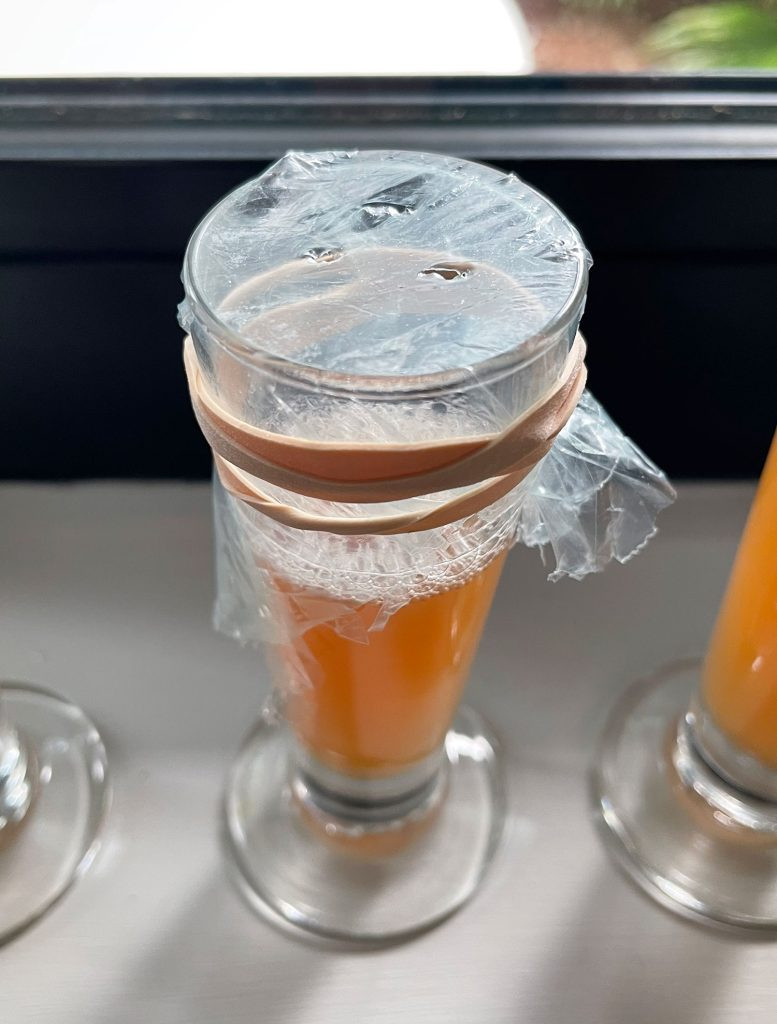 DIY Fruit Fly Trap With Apple Cider Vinegar And Plastic
DIY Fruit Fly Trap With Apple Cider Vinegar And Plastic
Instructions:
- Choose Your Container: Find a small, clear jar, cup, or glass container. Almost anything works, and it doesn’t need to be large. A clear container makes it easier to see the trapped flies, but an old soda or beer can also works.
- Add Apple Cider Vinegar: Pour apple cider vinegar into the container. The scent will attract the flies. Old beer or wine can also be used, but regular white vinegar will not work.
- Cover with Plastic: Tightly cover the opening with plastic wrap and secure it with a rubber band. Saran wrap works well, but you can also use scraps from a plastic bag.
- Poke Small Holes: Use a toothpick to poke a few small holes in the plastic wrap. The holes should be large enough for a fly to enter.
- Outdoor Release (Optional): Carefully take the trap outside without removing the plastic wrap. Remove the wrap and allow the flies to fly away.
Alternatively, you can poke a hole in a metal jar lid using a hammer and nail. Use a mason jar or an old food jar for this method.
2.3 How effective is a Dish Soap Fruit Fly Trap?
This fruit fly trap does not require a cover. Instead, it uses a soapy surface to trap the pests. Note that this method does not allow for outdoor release, as the flies become coated in soap.
Supplies Needed:
- Small container, bowl, or dish
- Dish soap
- Apple cider vinegar (ACV)
Instructions:
- Add Apple Cider Vinegar: Fill the bottom of a small container, bowl, or dish with apple cider vinegar to attract the fruit flies.
- Add Dish Soap & Mix: Add several drops of dish soap to the ACV and mix to create a soapy solution. Flies that land on the mixture will find it difficult to fly away.
This technique can also be combined with the plastic wrap or funnel method. Just add dish soap to the apple cider vinegar before covering the top to provide an additional way for the flies to get stuck.
2.4 How to create a Rotting Fruit Trap?
These traps replace apple cider vinegar with what fruit flies love most: actual fruit.
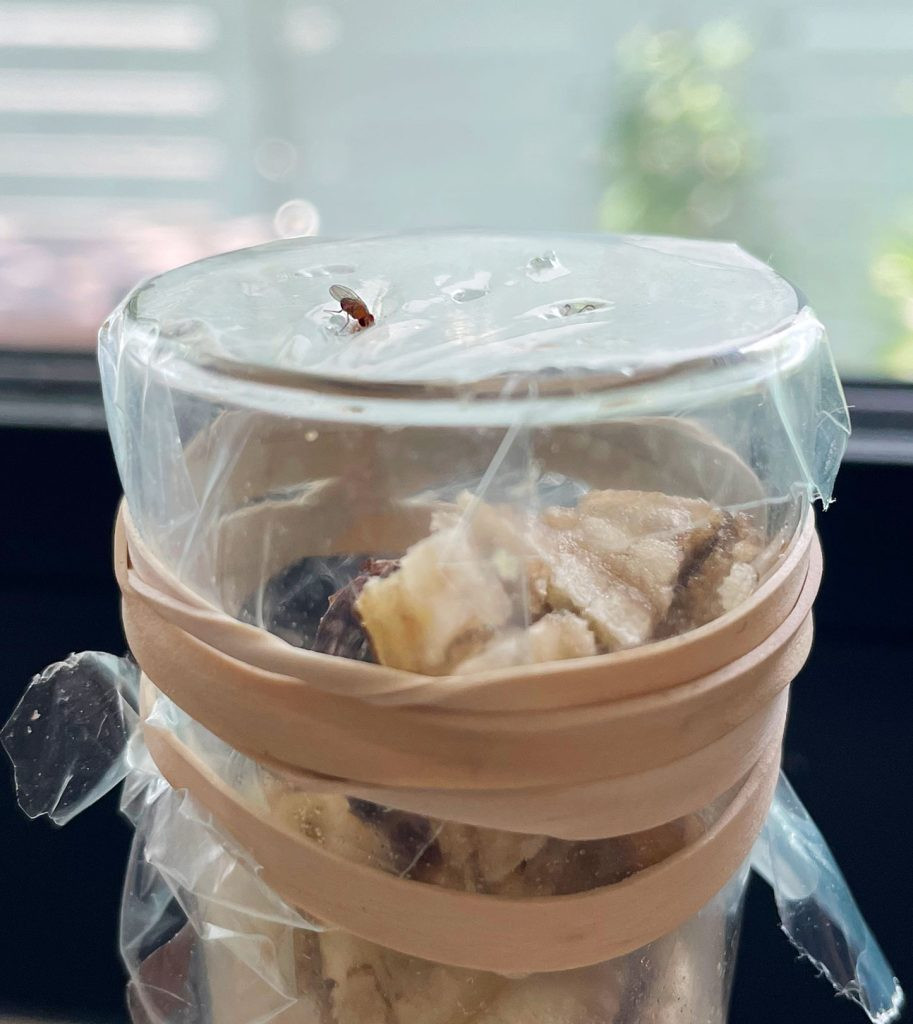 Fruit Fly Entering Plastic Wrap On DIY Trap
Fruit Fly Entering Plastic Wrap On DIY Trap
Supplies Needed:
- Small glass jar, cup, or container
- Plastic wrap or paper funnel, depending on your chosen trap mechanism
- A small fruit scrap, such as a banana peel or apple slice
Instructions:
To create a rotting fruit trap, substitute apple cider vinegar with a piece of banana peel, apple slice, or peach in either the plastic wrap or funnel trap. You can also add the fruit scrap to your ACV. Remember to replace the fruit scrap every day or two to prevent unwanted odors in your kitchen.
3. What is the Best Fruit Fly Trap?
Testing various DIY traps showed that the most effective factor was the lure used. Traps with banana peel performed significantly better than those with apple cider vinegar. Specifically, two plastic wrap traps were set up, one with banana peel and the other with ACV and soap. The banana peel trap dramatically outperformed the ACV and soap trap. This suggests that real fruit is more enticing than ACV.
The best approach is to add a fruit scrap to any trap you set up. The plastic wrap trap is slightly preferable because it is easier to make and less prone to accidental disruption.
3.1 Which Fruits Attract Fruit Flies the Most?
Further testing was done to determine which kind of fruit is the best bait. Three fruits were tested: a banana peel, apple slices, and a strawberry. Each was placed in a plastic wrap trap side-by-side on a countertop for 24 hours.
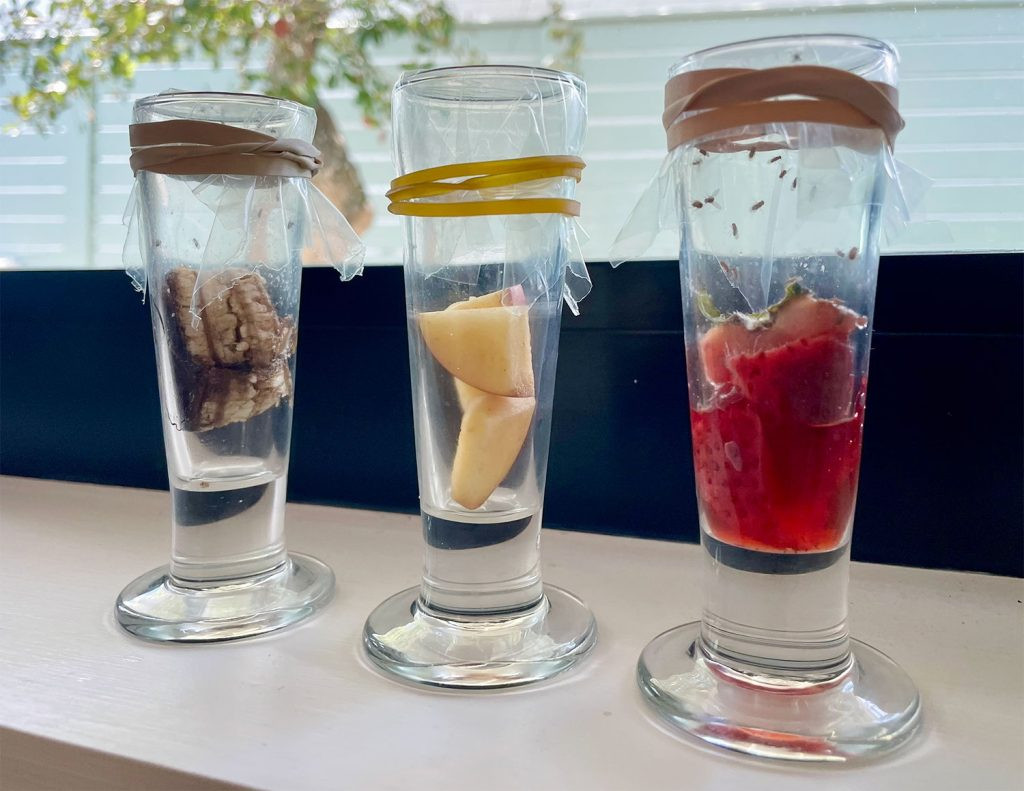 Fruit Fly Traps With Different Rotten Fruit Baits
Fruit Fly Traps With Different Rotten Fruit Baits
The fruit flies were most attracted to the strawberry. Although the banana peel started strong, the longer the strawberry rotted, the more flies it caught. The apple slices did not catch any flies.
4. Are Store-Bought Fruit Fly Traps Effective?
If DIY solutions are not effective or if you prefer a more convenient option, several pre-made traps are available for purchase. These traps have many positive reviews and typically cost less than $20. They may be a good choice if you want to catch other types of flying insects or prefer a more discreet trap.
During testing, a pack of Terro Traps was used to see if they performed better than homemade methods. One trap was left out for 24 hours next to the banana and strawberry traps.
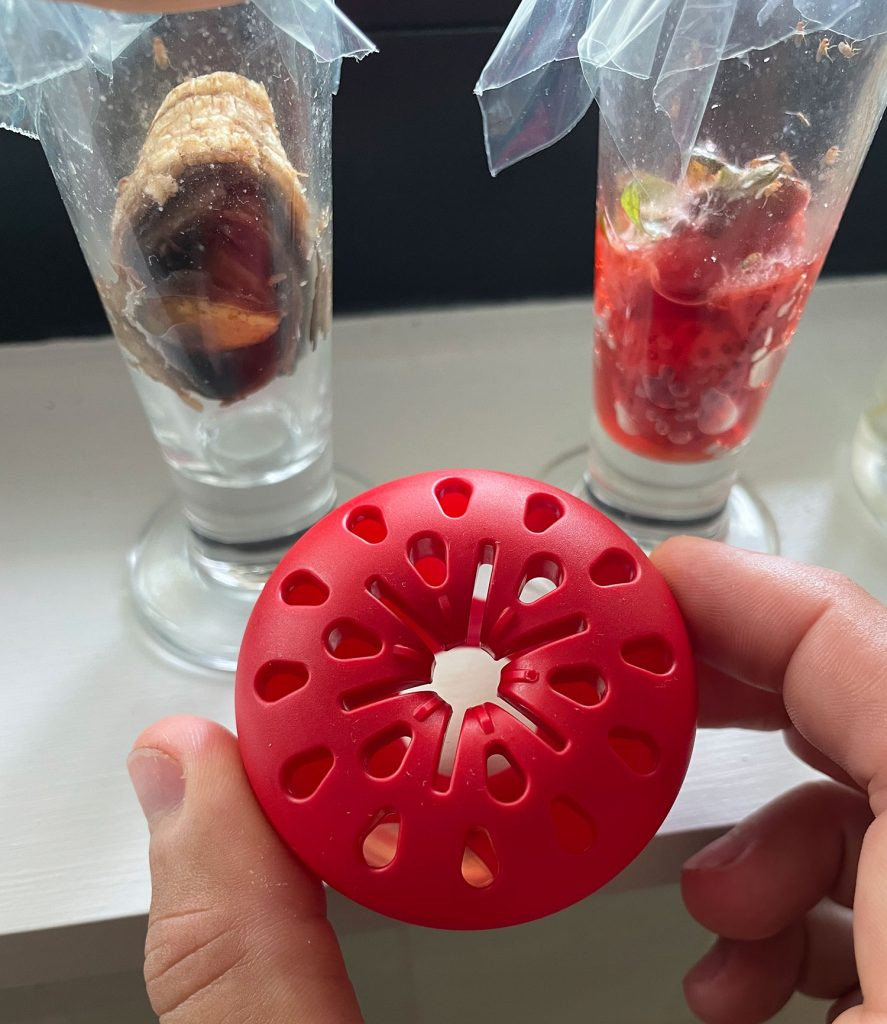 Terro Fruit Fly Apple Trap With No Fruit Flies In It
Terro Fruit Fly Apple Trap With No Fruit Flies In It
The homemade strawberry trap performed best, followed closely by the homemade banana peel trap. The store-bought trap caught only one fly. However, after discarding the DIY traps and leaving the store-bought trap out for another 24 hours, it caught a significant number of flies. This shows that store-bought traps do work, but they may not be as fast or effective as homemade traps. Store-bought traps are a good option if you want something more discreet, especially if you plan to leave it out indefinitely.
5. What are the Best Ways to Prevent Fruit Flies?
While getting rid of fruit flies is relatively simple, preventing them from infesting your home is ideal. Here are some easy ways to prevent fruit flies:
- Clean Kitchen Surfaces: Wipe down kitchen counters, stovetops, tables, and any other surfaces that may collect food residue or spilled liquids. Fruit flies are particularly attracted to fruit, sweet juices, and alcohol, so ensure these are cleaned up promptly.
- Take Out Your Trash: Food scraps left in your garbage overnight can turn your trash can into a breeding ground for fruit flies.
- Dispose of Overripe Fruit: Regularly check your fruit bowl for overripe or rotting fruit and dispose of it before it becomes a problem.
- Wash Your Fruit as Soon as You Get It Home: Washing produce immediately after bringing it home can eliminate any eggs or larvae that may be present (except for berries, which could rot faster from the moisture).
- Store Produce in the Fridge When Possible: Fruit flies do not thrive in cold environments, so storing fruits and vegetables in the refrigerator can prevent them from becoming a food source.
- Clean Your Sink Drain: Food scraps in your sink drain can attract fruit flies. Regularly run your garbage disposal and flush the drain to keep it clean.
It’s important not to panic if you spot fruit flies in your home. Taking quick action can prevent the problem from worsening. The solutions listed above are easy, effective, and fast-acting.
6. FAQ: How to Get Rid of Fruit Flies
6.1 What attracts fruit flies to my home?
Fruit flies are attracted to ripe, rotting, or fermenting fruits and vegetables. They are also drawn to sugary liquids like juice, beer, and wine.
6.2 How do I know if I have a fruit fly infestation?
You’ll likely see small flies buzzing around fruit bowls, garbage cans, sinks, and other areas where food may be present.
6.3 How quickly can a fruit fly infestation get out of control?
Fruit flies can reproduce rapidly. Females can lay hundreds of eggs, which hatch in as little as 12 hours. The flies can reach adulthood in just a few days, leading to a quick increase in population.
6.4 Are fruit flies dangerous?
Fruit flies are generally harmless, but they can be a nuisance. They don’t bite or sting, but they can contaminate food.
6.5 What is the best way to get rid of fruit flies naturally?
DIY traps using apple cider vinegar, dish soap, and rotting fruit are effective natural solutions. Regular cleaning and proper food storage are also important.
6.6 Can fruit flies live in drains?
Yes, fruit flies can breed in drains if there are food scraps present. Cleaning drains regularly can help prevent infestations.
6.7 How do I clean my sink drain to prevent fruit flies?
Flush the drain with hot water and vinegar. You can also use a drain cleaner or a mixture of baking soda and vinegar.
6.8 Do fruit fly traps really work?
Yes, fruit fly traps can be very effective, especially when baited with substances that attract them, such as apple cider vinegar or rotting fruit.
6.9 How long does it take to get rid of a fruit fly infestation?
With consistent effort, you can typically get rid of a fruit fly infestation within a week or two. Regular cleaning and trapping are key.
6.10 Are there any commercial products that effectively eliminate fruit flies?
Yes, several commercial fruit fly traps are available. These traps often contain a lure that attracts the flies, and they can be effective if used correctly. Terro Traps are a popular option.
By implementing these strategies, you can maintain a fruit fly-free home and enjoy a cleaner, more pleasant living environment. For more tips and resources, visit flyermedia.net to explore a wide range of articles and solutions. Discover valuable insights on pest control methods and eco-friendly cleaning practices, all designed to help you create a healthier and more comfortable home.
